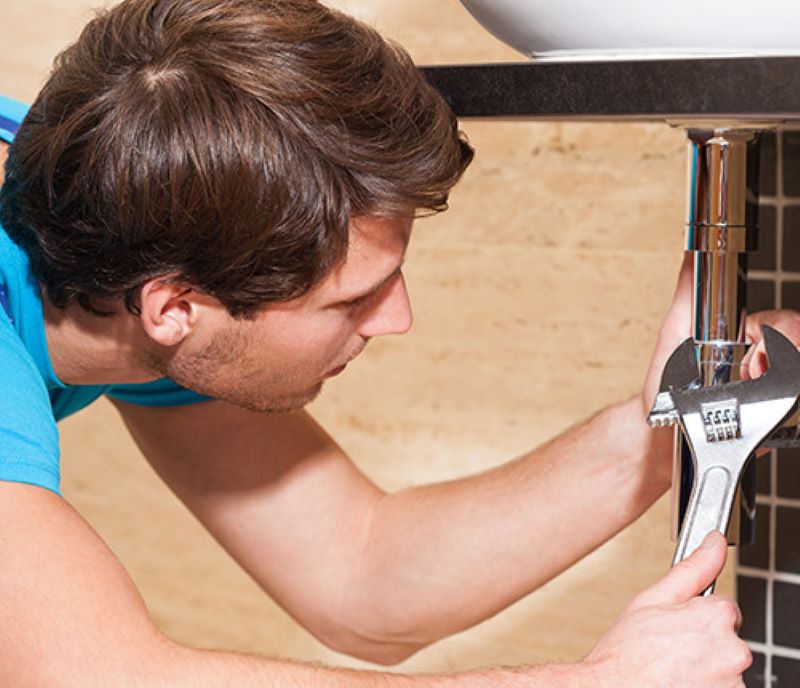There’s never a good time for plumbing emergencies to occur, and they seem to happen at the most inopportune times, such as nights and weekends. While there are a lot of issues that need to be addressed by a qualified, skilled technician, there are other plumbing problems that the average do-it-yourselfer can handle. Here are a few of them. However, it is very important to note that if you have any doubt whatsoever that you can take care of a project on your own, make the safe, smart choice and call a professional.
Project No. 1: Unclog a Drain
This is one of the most important plumbing repairs that a novice can learn to perform, because when a drain is clogged, the fixtures associated with that line will be basically useless.
Let’s start with a clog in your kitchen sink. Most of us have double sinks in this part of the house. If you need to clear a clog, first plug one of the drain holes (the one that has no standing water will be best) with a stopper. Cover the other with a plunger and move it up and down to try and remove the obstruction, but you need to be very careful. If you use too much force with the plunger you may run the risk of disconnecting the pipe under your sink.
One way you can prevent a kitchen sink clog is by making sure you don’t put certain items in your garbage disposal. These include onion skins, grease or potato peels. Each time you use the disposal, always run water to help materials run down the drain correctly.
Project No. 2: Clean Your Faucet Aerators
The aerator is the little screen where water comes out of your faucet. Sometimes, minerals and other materials can accumulate on the screen and cause a substantial loss in water flow. Cleaning the screen is easy, but taking it off can sometimes be a chore.
First, turn off the water supply to the sink in order to prevent a mess from taking place. You can either do this by turning off the valve under the sink or by turning off the main water valve supplying your house. Use some masking tape to protect your faucet’s finish, and then unscrew the aerator by using a pair of pliers.
Once you do this, take out the screen and soak it in vinegar for a little while (30 minutes to an hour) to clean it. Scrub it with a brush for a deeper clean. Then, put the screen back on the aerator, screw it back on the threads, and tighten with pliers — make sure the masking tape is still attached so you don’t scratch the finish.
Think about having a water softener installed. This will help reduce buildup and help ensure water flows properly through your faucet.
Project No. 3: Drain and Flush Your Water Heater Tank
Drain about five gallons from the tanks drain spigot every six months. That flushes the sediment out of the bottom before it can harden and build up, keeping the heater energy efficient and maximizing its life. Sediment is your water heater’s biggest enemy — if it is allowed to accumulate, it will corrode the tank’s internal elements and eventually cause a breakdown.
First, make sure you read your owner’s manual for instructions that are specific to your model of water heater. Also, once the tank has been drained and cleaned, it will need to be completely refilled before you turn the gas or electricity back on.
Then, cut the power supply to the unit first and let it cool down. You’ll then need to shut off the water supply. You will probably be able to find it on a pipe entering the unit from the wall — either above the water heater or next to it. Next, find the drain valve and connect a garden hose to it. Run the other end of the hose into your driveway to be on the safe side, because the water coming out will not only be hot, it will also probably contain salt that could damage grass or plants. Turn the valve so the water can drain — you may need to use a screwdriver to do so. If you’re not sure how to open the valve, look at your owner’s manual or call a plumber.
After the tank is empty, turn on the cold water so it can flush out any sediment that remains. Check the drain hose to see if the water coming out is clear. Once it is, you’re done cleaning the tank. Close the drain valve, undo the hose, fill the tank and turn the power back on. You’ll probably want to do this once a year to keep your water heater running at its best.
These are just a few of the plumbing projects you can do by yourself. Just remember to take all necessary safety precautions and call a professional if you ever feel you’re in over your head. We recommend you read your owner’s manual for instructions that are specific to your model of water heater. If you no longer have a manual, they can often be located on the web.













helloI like your writing very so much proportion we keep up a correspondence extra approximately your post on AOL I need an expert in this space to unravel my problem May be that is you Taking a look forward to see you